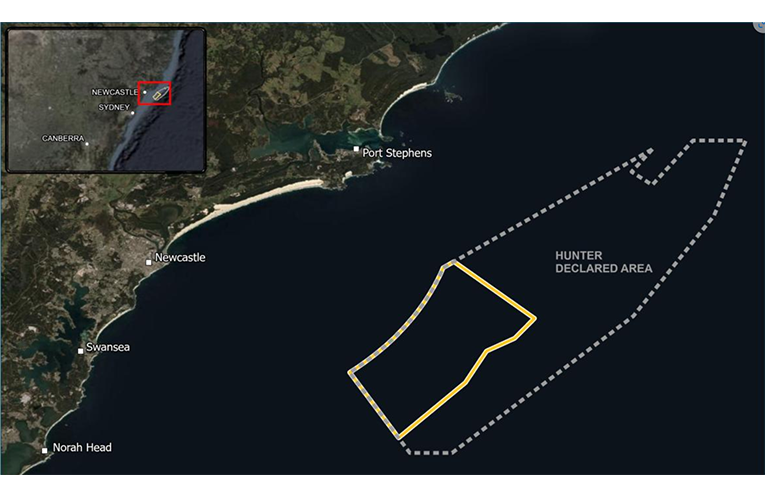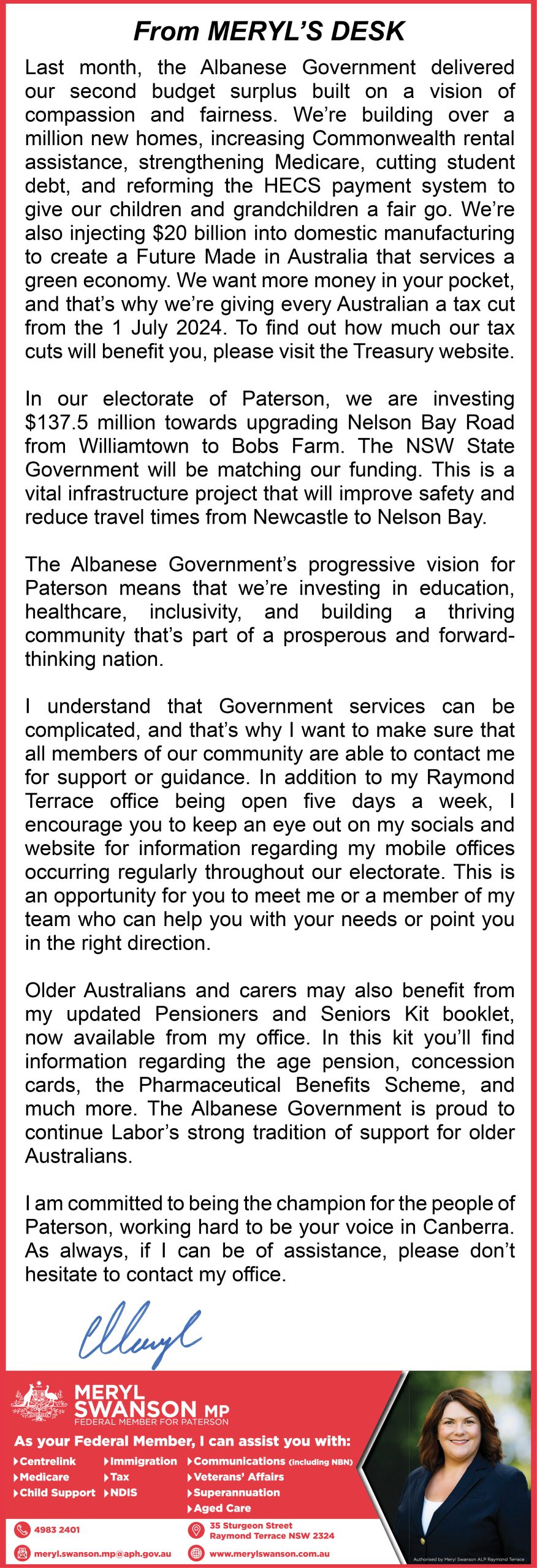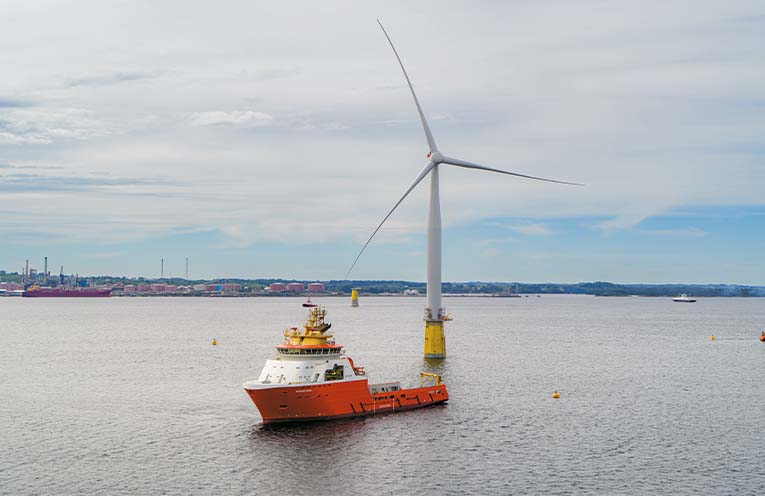
AUSTRALIA’S first floating wind farm is one step closer to becoming a reality, with a licence issued to explore the feasibility of a large-scale renewable energy project in the Hunter offshore wind zone.
Equinor and Oceanex Energy’s Novocastrian Wind Pty Ltd is the only project to be offered a feasibility licence initially, despite the proposed project area only taking up around 40 percent of the total declared zone.
 Advertise with News of The Area today.
Advertise with News of The Area today.It’s worth it for your business.
Message us.
Phone us – (02) 4981 8882.
Email us – media@newsofthearea.com.au
“Other applications were for overlapping areas and found to be of lower merit,” the Department of Climate Change, Energy, the Environment and Water stated on Friday.
The Equinor and Oceanex project is proposed for the southern end of the declared zone, around 20 kilometres off the coast, predominantly off Lake Macquarie, Newcastle and the southern end of Port Stephens.
The project, if it proceeds, is expected to employ around 3,000 workers during construction and create around 200–300 permanent local jobs.
The Department claims the project will “inject development expenditure worth hundreds of millions of dollars” into the Hunter region and leverage existing heavy industry.
Proponents say the offshore wind farm has the potential to generate over two gigawatts (GW) of electricity, equivalent to powering 1.2 million homes or two Tomago smelters.
“The Hunter has been an industrial and economic powerhouse for generations, and my decision today is a big step towards providing that powerhouse with reliable renewables,” Minister for Climate Change and Energy Chris Bowen said.
“The project I’ve shortlisted offers the biggest rewards for the Hunter and Australia – supporting our workforce and energy security, protecting our environment and sharing our marine space with the people and industries who rely on it today.”
A spokesperson for Oceanex Energy told News Of The Area the announcement was the beginning of a seven-year research and consultation period.
“We will work with our partner Equinor and government through this preliminary award process and be prepared to continue with the early-stage development of the project.
“This includes working with community, First Nations groups, industry and universities to ensure we get the foundations right for a world-class project.
“The community will be involved in this process through detailed consultation and information sessions, and a chance to shape what we think will be an incredible new industry for the region.”
Oceanex says the southern end of the declared zone was chosen for the project due to its close proximity to the Port of Newcastle.
“[That is] where the majority of work will take place, the majority of jobs will be based, and it is closer to the transmission point for electricity.
“This will assist cheaper electricity being provided than if the project was further away.”
Member for Newcastle Sharon Claydon said no other region is as well placed to take advantage of the opportunities presented by the offshore wind industry.
“Newcastle’s world class infrastructure, our deepwater port, skilled workforce, abundant resources and energy smarts means our region is poised to lead this transformation,” Ms Claydon said.
“A new offshore wind industry in Newcastle means new jobs in local manufacturing, construction, maritime, transport and logistics industries, as well as growing our vocational education and training pathways – at TAFE and university.”
Mr Bowen has indicated further consultation with First Nations groups, communities, unions and marine users will continue throughout the feasibility licence process, while environmental studies and a detailed management plan is prepared.
The Department has also highlighted requirements for offshore wind developers to consult with fishers and “avoid, mitigate and offset any impacts on fishing”.
According to the Minister, recreational fishers may be able to travel and fish within the offshore wind zone with exclusion zones in place, citing examples where this occurs in Europe.
Local fishers however, will believe it when they see it.
“Mr Bowen is now spruiking that there will only be a 50 metre exclusion zone,” said Troy Radford, President of the Newcastle and Port Stephens Game Fish Club (NPSGFC).
“The fact is that legislation currently is 500 metres.
“We are not going to be allowed to fish in there.
“Even if we were…if it [offshore wind cabling) doesn’t stop the bait fish from congregating there, we still won’t be able to fish in there because the fish will tangle around the cables and ropes.”
Mr Radford said the area proposed for the offshore wind farm is home to one of the region’s iconic offshore fishing sites, known as the ‘car park’.
“In twenty years, nearly 20,000 fish have been tagged in that area,” Mr Radford said.
“That is huge.
“He [Chris Bowen] has taken no consideration into that at all, and again just hasn’t listened.”
Mr Radford also expressed disappointment over a lack of consultation between the Novocastrian Wind proponents and the fishing club.
“It’s very disappointing that no Equinor or Oceanex representatives have made contact with the NPSGFC to discuss any aspects of their planned project within the Hunter offshore wind zone.
“Not even a brief introduction to start the consultation process.
“The NPSGFC is a key stakeholder, recognised by the Australian Government, and they can’t even pick up the phone?
“How’s that for consultation!”
On the issue of fishing, offshore wind developers Oceanex Energy say detailed consultation will be undertaken over the seven-year feasibility licence period to “ensure we understand what impact there is, if any, and how it can be minimised”.
“In many areas around the world, offshore wind farms have been found to stimulate increased fishing opportunities,” an Oceanex spokesperson told NOTA.
Lyne Nationals MP David Gillespie has slammed the announcement of the feasibility licence being awarded, labelling it a “slap in the face to the Port Stephens and Myall Coast communities”.
“This is not a community opposed to renewables, just opposed to renewables that threaten their livelihoods and the environment they treasure,” Dr Gillespie said.
“The Minister continues to try and sell this project as providing reliable renewable energy.
“There is nothing reliable about wind energy.
“While the Minister likes to quote nameplate capacity, we know that the average actual capacity for a wind farm is 35 percent.”
The region’s union bodies, however, have welcomed the announcement.
“The Hunter Jobs Alliance is excited to continue engagement with Oceanex and Equinor to work on maximising local jobs, supply chains, manufacturing, best practice environmental mitigation strategies, and community benefits for our region,” said Justin Page, coordinator of the Hunter Jobs Alliance.
“We have had good engagement with this wind proponent leading up to this point and can now work on ensuring there is good community consultation throughout the environmental assessment stage to have genuine environmental concerns heard and addressed.”
Mr Page said the Department was consulting locally on regulations impacting the burgeoning offshore wind industry.
“There has been consultation on licence conditions including local content, local jobs and supply chains, transmission, safety zones, work health and safety, financial securities, and management plans to underpin community and key stakeholder consultation requirements.”
Jo Lynch of the Hunter Community Environment Centre said, “The commencement of environmental sites studies is a crucial phase in the development process for offshore wind and we look forward to working with successful proponents to ensure the Hunter’s offshore wind industry is ecologically sustainable.”
Mark Watson, an independent Port Stephens Mayoral candidate, described the licence announcement as “a huge insult to the residents of Port Stephens”.
“It is quite clear that a large portion of residents oppose the offshore wind farm which will heavily impact the fabric of the community, the environment and livelihoods of many,” he said.
“There is no social licence granted by the community; the Minister should not be able to just walk in and destroy what the locals hold dearest to them, which is the natural beauty that Port Stephens has to offer.
“The so-called ‘3000 jobs created’ does not take into account the long term ramifications of a region that relies heavily on environmental tourism, hospitality, commercial and recreational fishing.
“The Minister by his own admission does not even think fishing takes place ‘that far out’ in the declared zone,” Mr Watson said.
Local environmental group EcoNetwork, which believes “offshore wind can be an important part of the renewable energy mix”, is waiting until more is known about environmental impacts before taking a position.
“Greenpeace says whales are not impacted, but we need to see the details in the environmental assessments, including any possible impacts on migratory and other bird species, and how they can be mitigated,” said Sue Olsson, the group’s vice president.
“In the meantime, climate change remains the primary threat to life on the planet, and that needs to be addressed urgently, including transitioning to renewable energy as soon as possible.”
If the Novocastrian Wind project is proven to be feasible, Oceanex and Equinor can then apply for a commercial licence to build an offshore wind project to generate electricity commercially.
By Doug CONNOR


The largest offshore floating wind farm in the world has only 11 turbines which supply Equinor’s gas platform in the North Sea. Hardly a valid comparison with the thousands of turbines proposed for about 135,000 square kms in the so far proposed 6 marine areas in Australian waters.